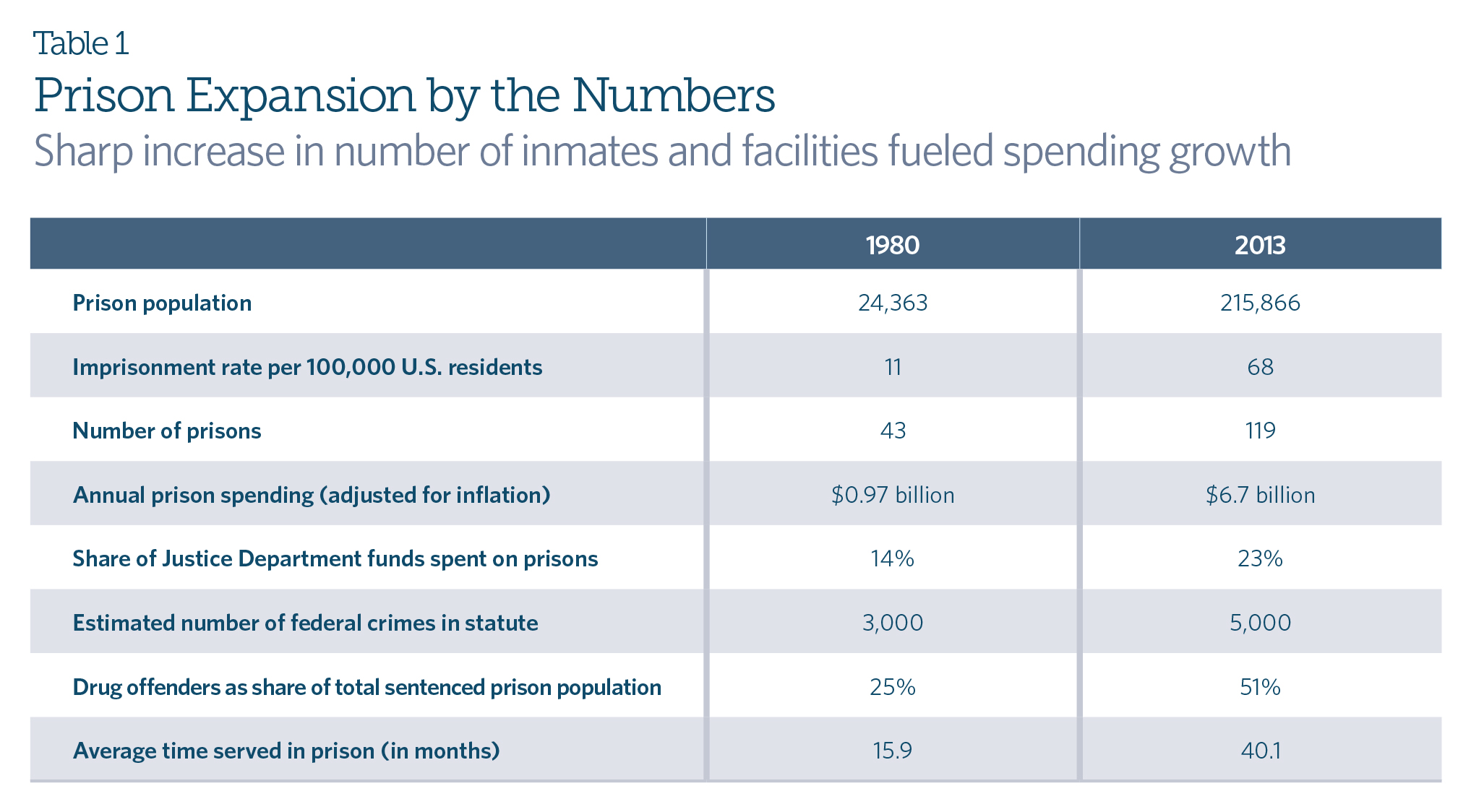Federal Prison System Shows Dramatic Long-Term Growth
Policy decisions contribute to steep rise in inmate population and costs
From 1980 to 2013, the number of offenders incarcerated in federal prisons increased from approximately 24,000 to more than 215,000, making the federal system the largest in the nation.1 Policy choices contributed significantly to this expansion as lawmakers added criminal laws to the books, lengthened sentences, and abolished parole.2 To accommodate the growing inmate population, the number of federal prisons nearly tripled, driving a surge in corrections spending.3 Taxpayers spent almost as much on federal prisons in 2013—$6.7 billion—as they spent to fund the entire U.S. Department of Justice in 1980, after adjusting for inflation.4 Despite these expenditures, recent data show that a third of all offenders who leave federal prisons under community supervision return to custody for violating the terms of their release.5

Notes: All spending figures are adjusted to 2013 dollars. Those for the prison system do not include federal grants to states or funding for Federal Prison Industries Inc., a wholly owned corporation of the U.S. government that employs and provides job training to inmates. Justice Department spending figures do not include one-time expenditures for the September 11th Victim Compensation Fund.
Source: Office of Management and Budget, “Public Budget Database: Outlays,” http://www.whitehouse.gov/omb/budget/
Supplemental
© 2015 The Pew Charitable Trusts

Notes: The federal prison population peaked at 217,815 inmates in 2012. The federal imprisonment rate peaked at 69 inmates per 100,000 U.S. residents, also in 2012. The proportion of drug offenders as a share of the total sentenced prison population peaked at 61 percent in 1994. Prison system expenditure figures do not include federal grants to states or funding for Federal Prison Industries Inc., a wholly owned corporation of the U.S. government that employs and provides job training to inmates. Justice Department spending figures do not include one-time expenditures for the September 11th Victim Compensation Fund. The number of federal crimes in statute is an approximation that does not include regulatory offenses, such as environmental infractions.
Source: Bureau of Justice Statistics; Bureau of Prisons; Justice Department; Office of Management and Budget; Dr. John S. Baker, visiting professor, Georgetown University Law School and consultant to the House Judiciary Committee Over-Criminalization Task Force
© 2015 The Pew Charitable Trusts
Endnotes
- U.S. Bureau of Justice Statistics, Corrections Statistical Analysis Tool, http://www.bjs.gov/index.cfm?ty=nps. Figures are calculated using end-of-year, total jurisdictional offender populations.
- Nathan James, The Federal Prison Population Buildup: Overview, Policy Changes, Issues, and Options (Washington: Congressional Research Service, 2014), https://www.fas.org/sgp/crs/misc/R42937.pdf.
- For the number of prisons in 1980, see Federal Prison System, 1980 Report (print publication only). For 2013, see U.S. Department of Justice, “FY 2014 Performance Budget: Congressional Submission for Federal Prison System Salaries and Expenses,” http://www.justice. gov/sites/default/files/jmd/legacy/2014/05/08/bop-se-justification.pdf.
- Office of Management and Budget, “Public Budget Database: Outlays,” http://www.whitehouse.gov/omb/budget/Supplemental. The Justice Department spent $6.9 billion in 1980 (adjusted for inflation).
- U.S. Sentencing Commission, Federal Offenders Sentenced to Supervised Release (Washington: 2010), http://www.ussc.gov/sites/default/ files/pdf/training/annual-national-training-seminar/2012/2_Federal_Offenders_Sentenced_to_Supervised_Release.pdf.






